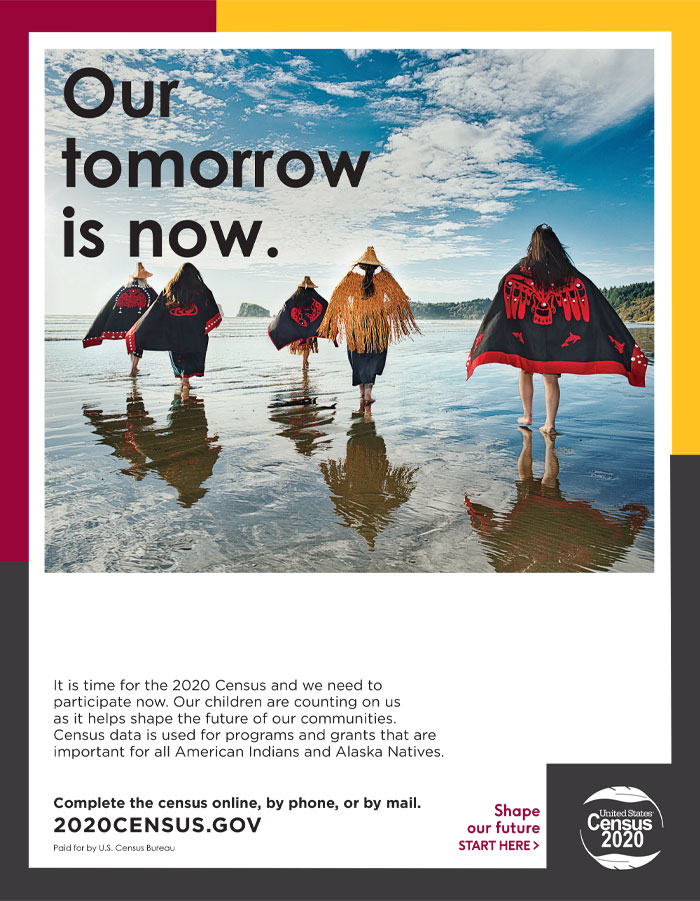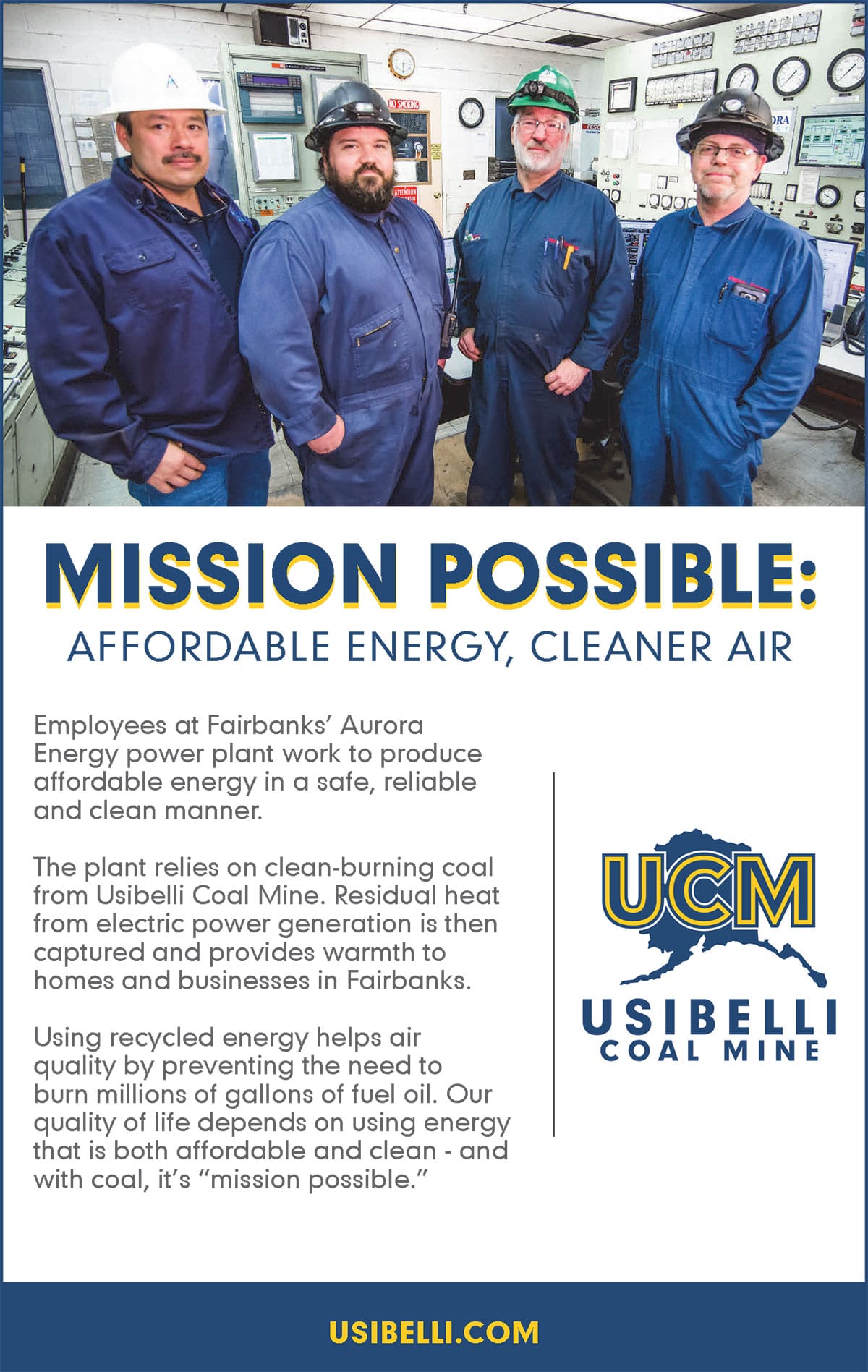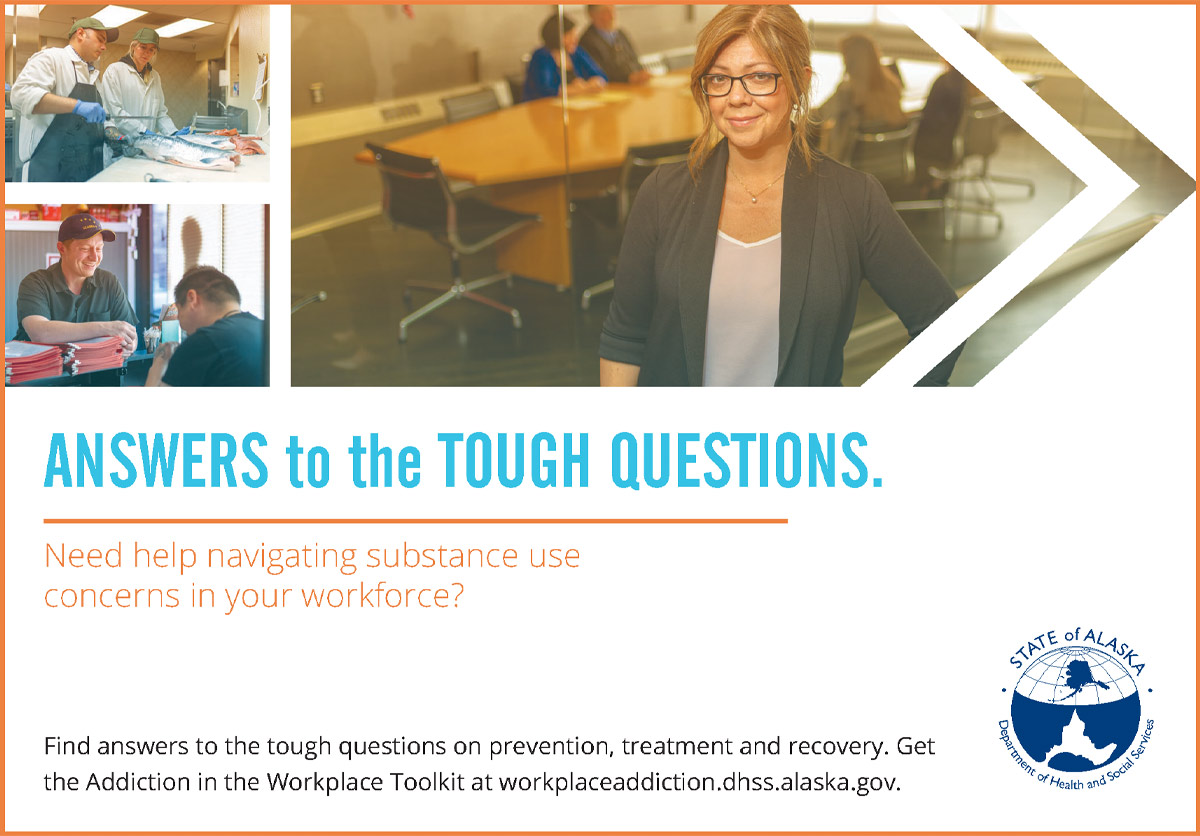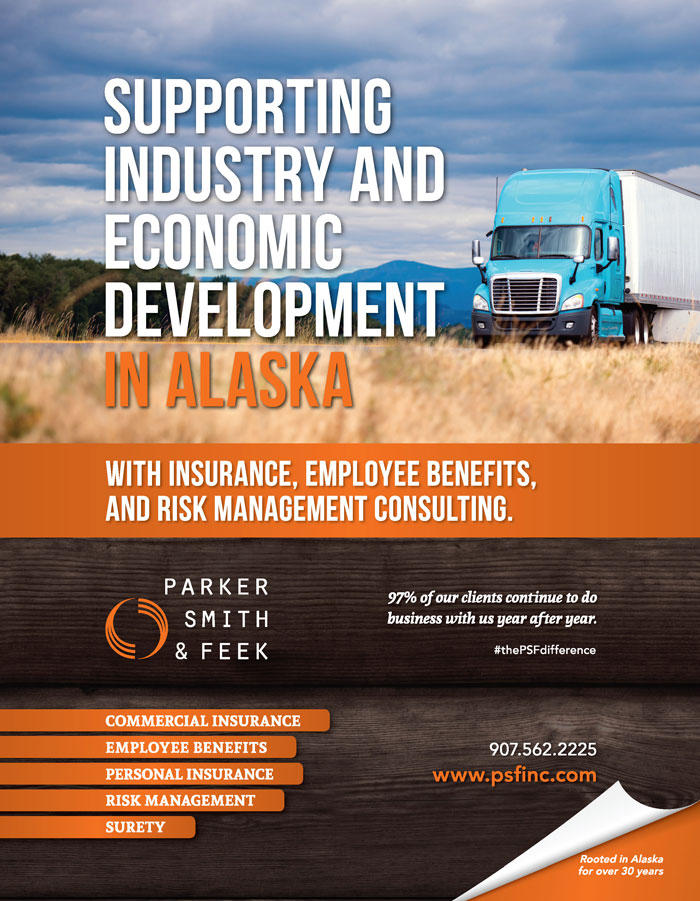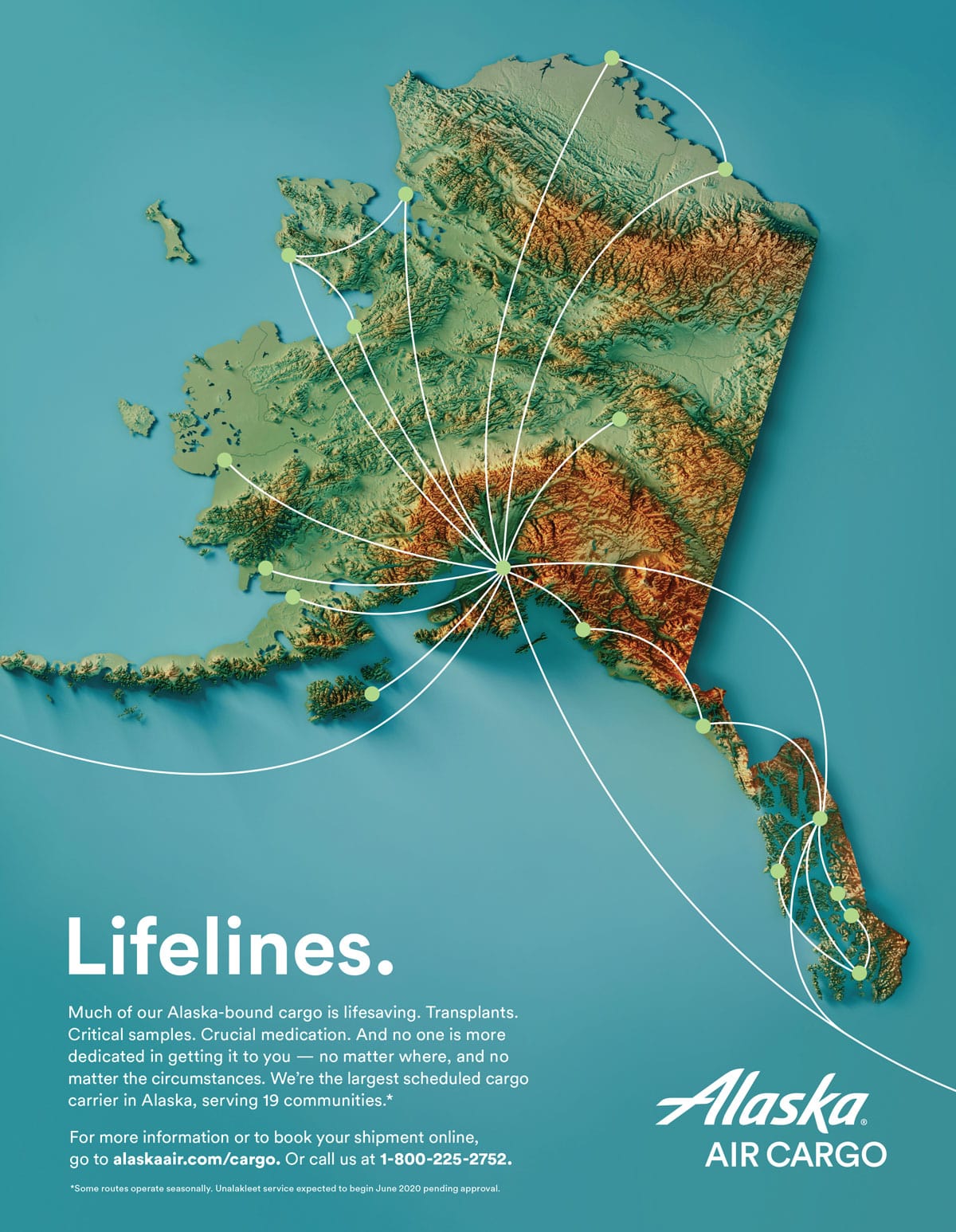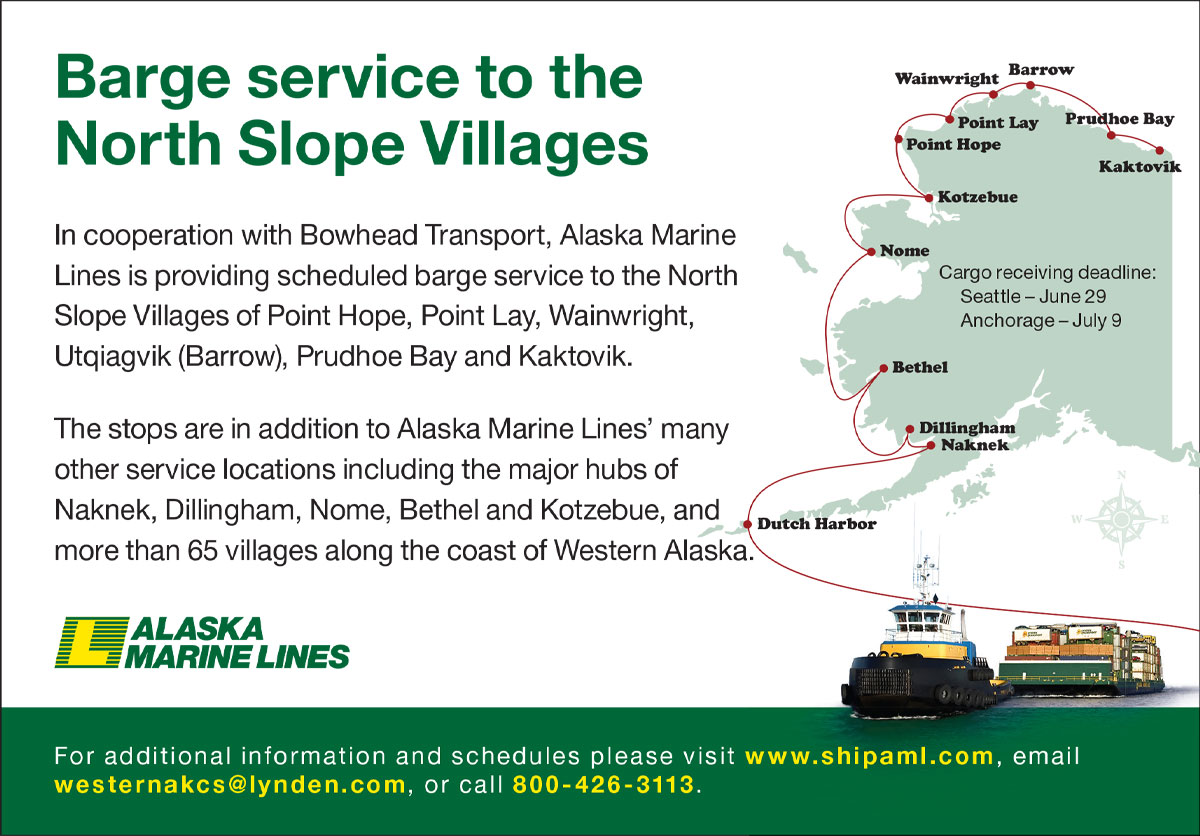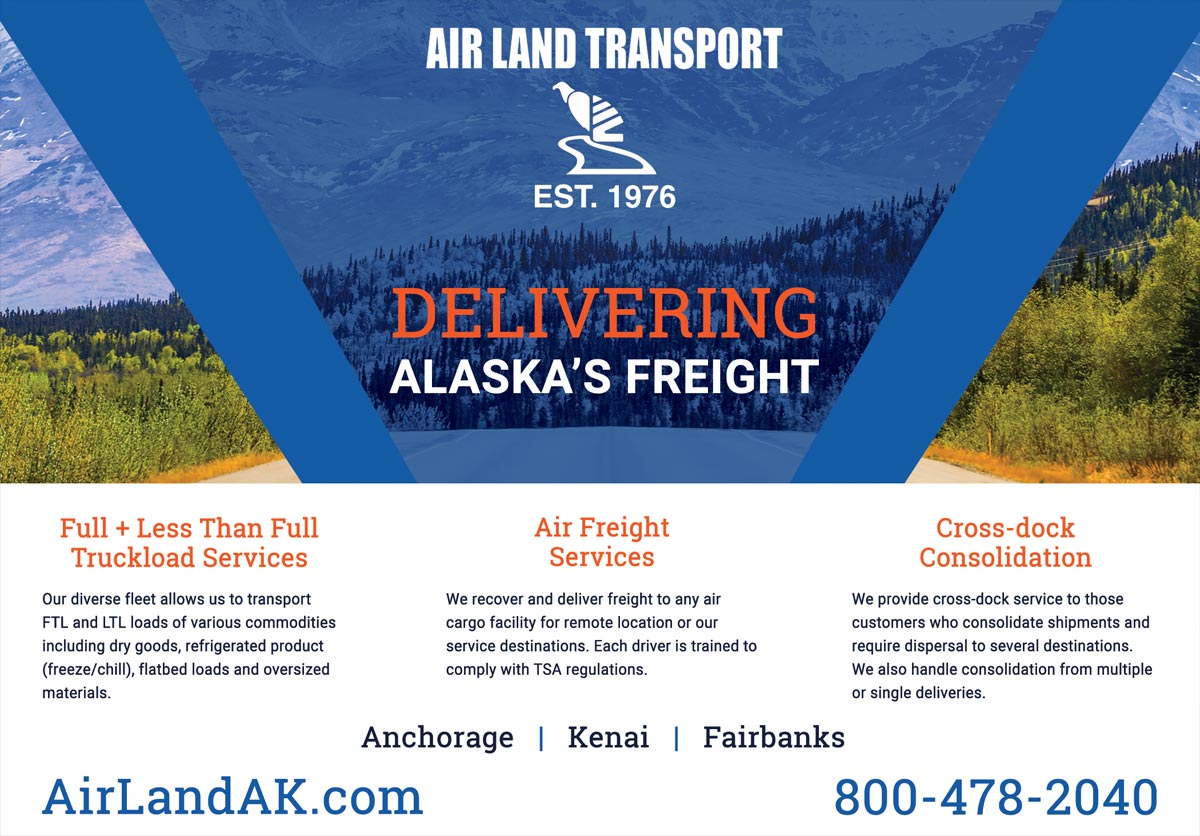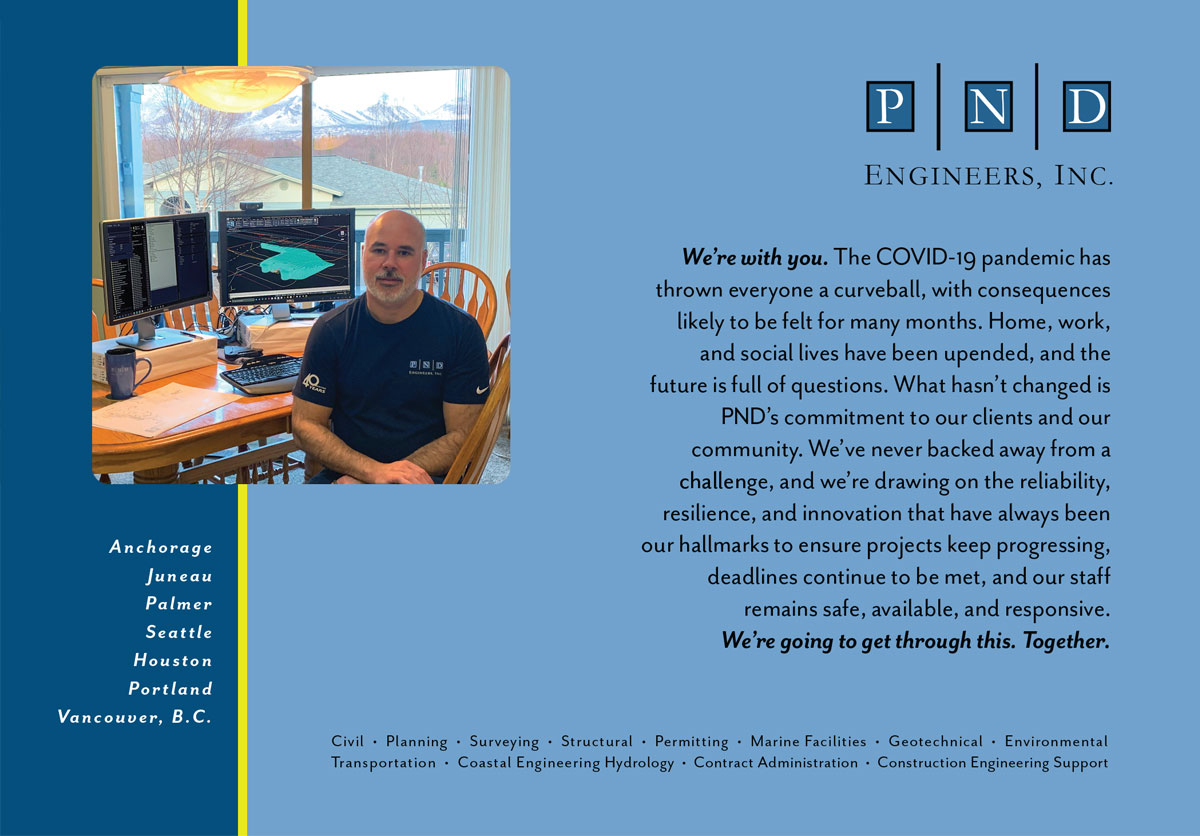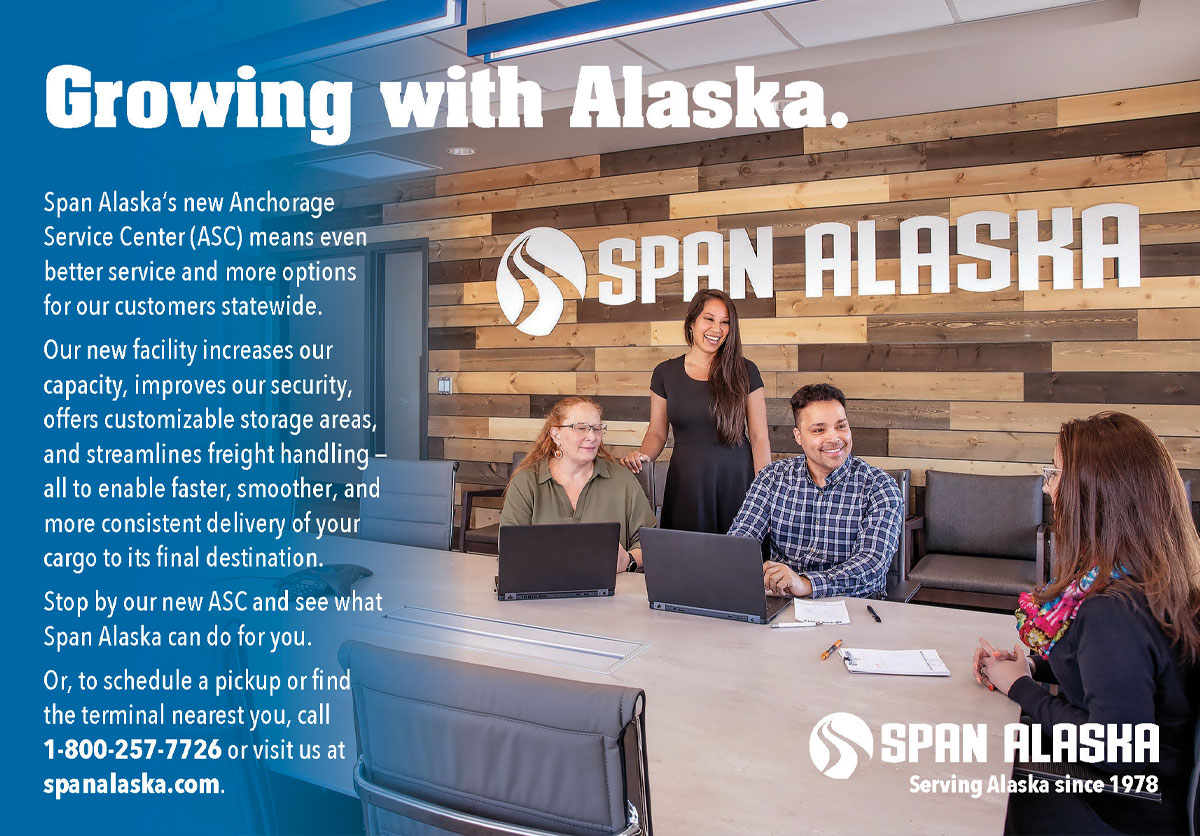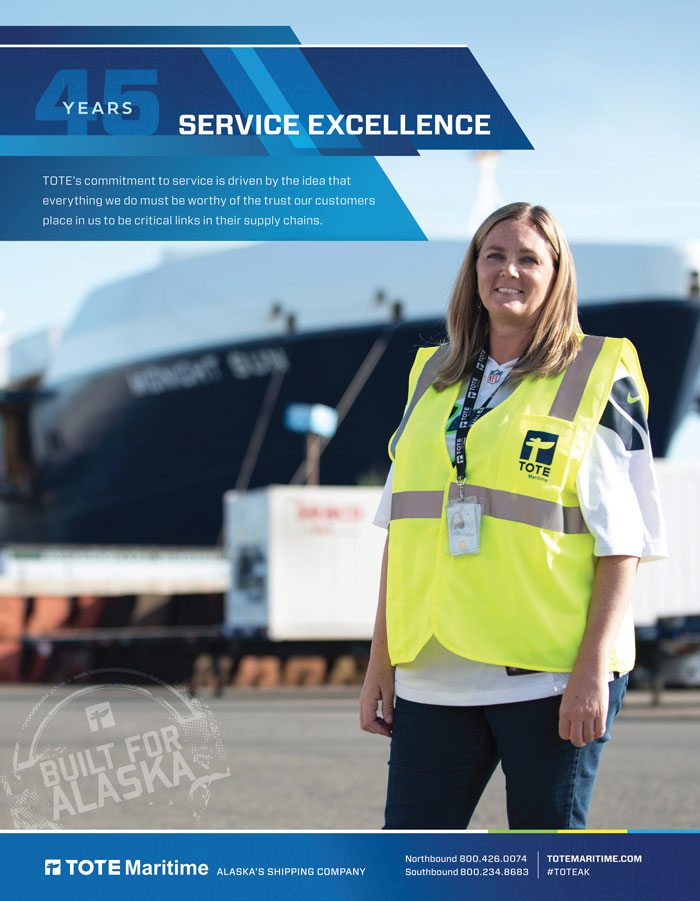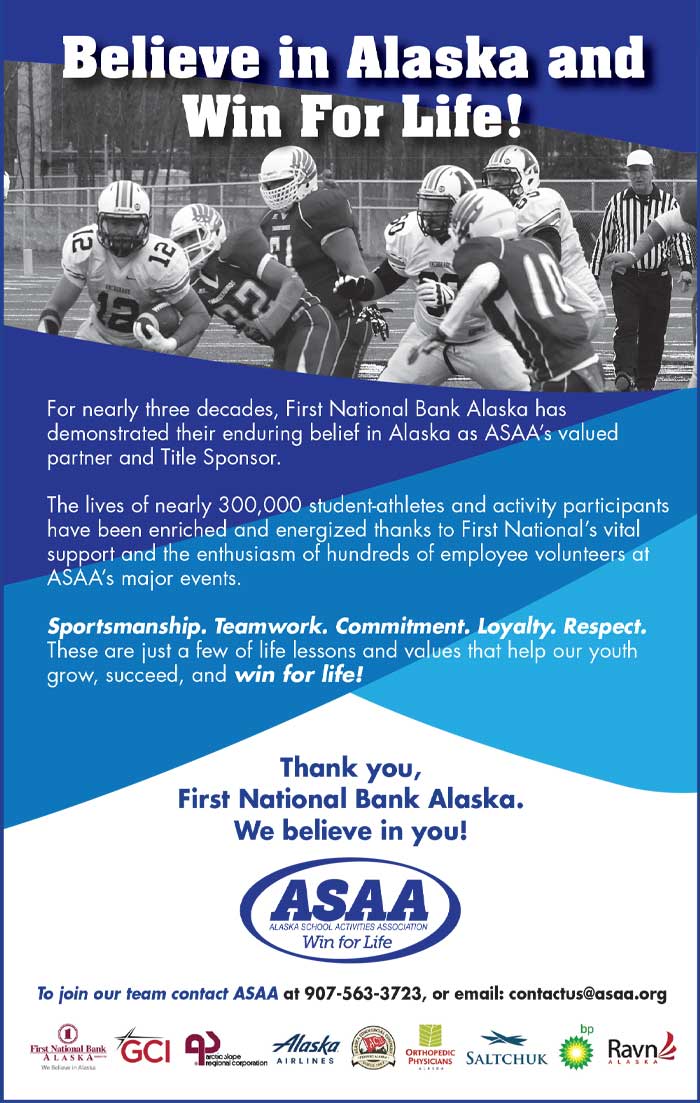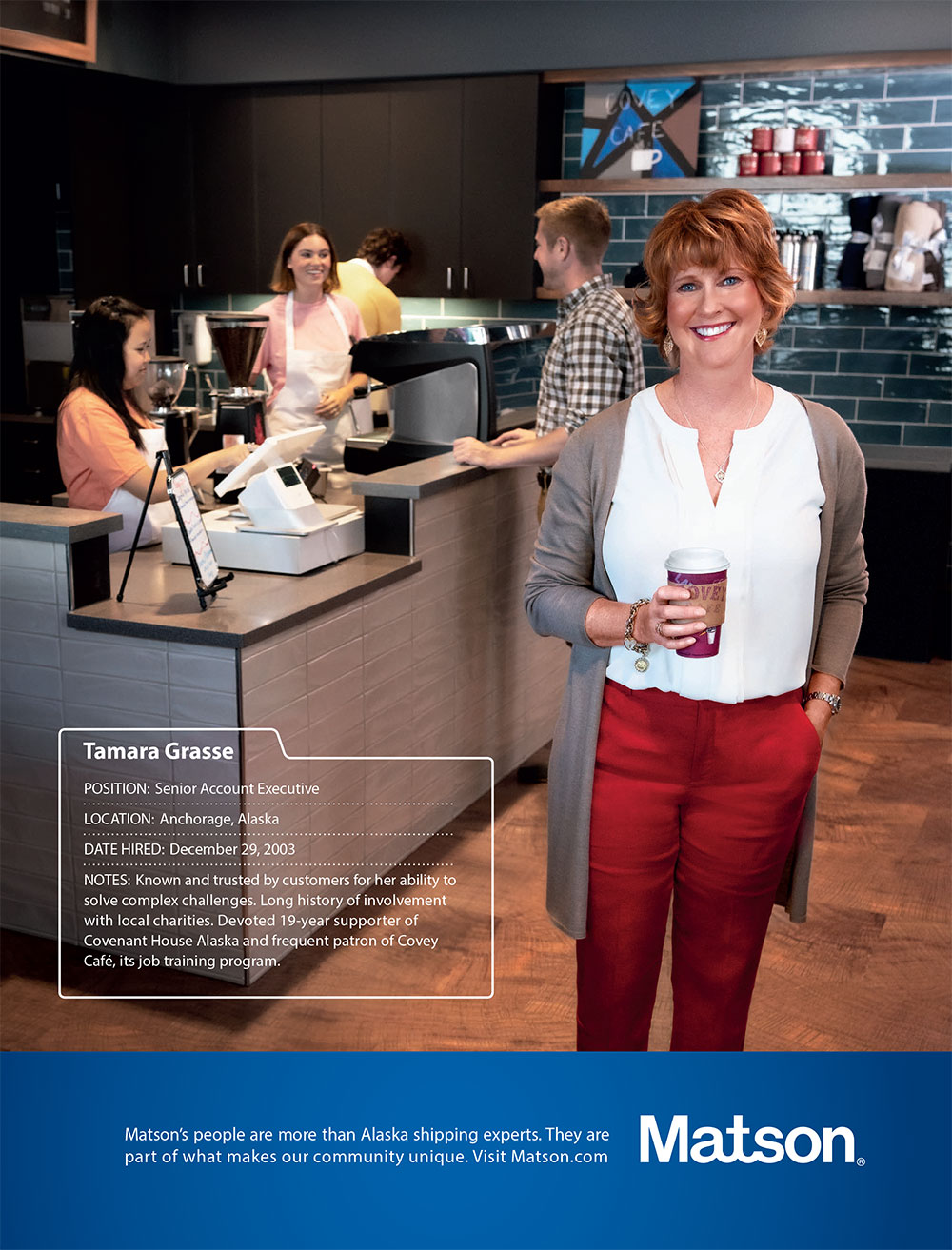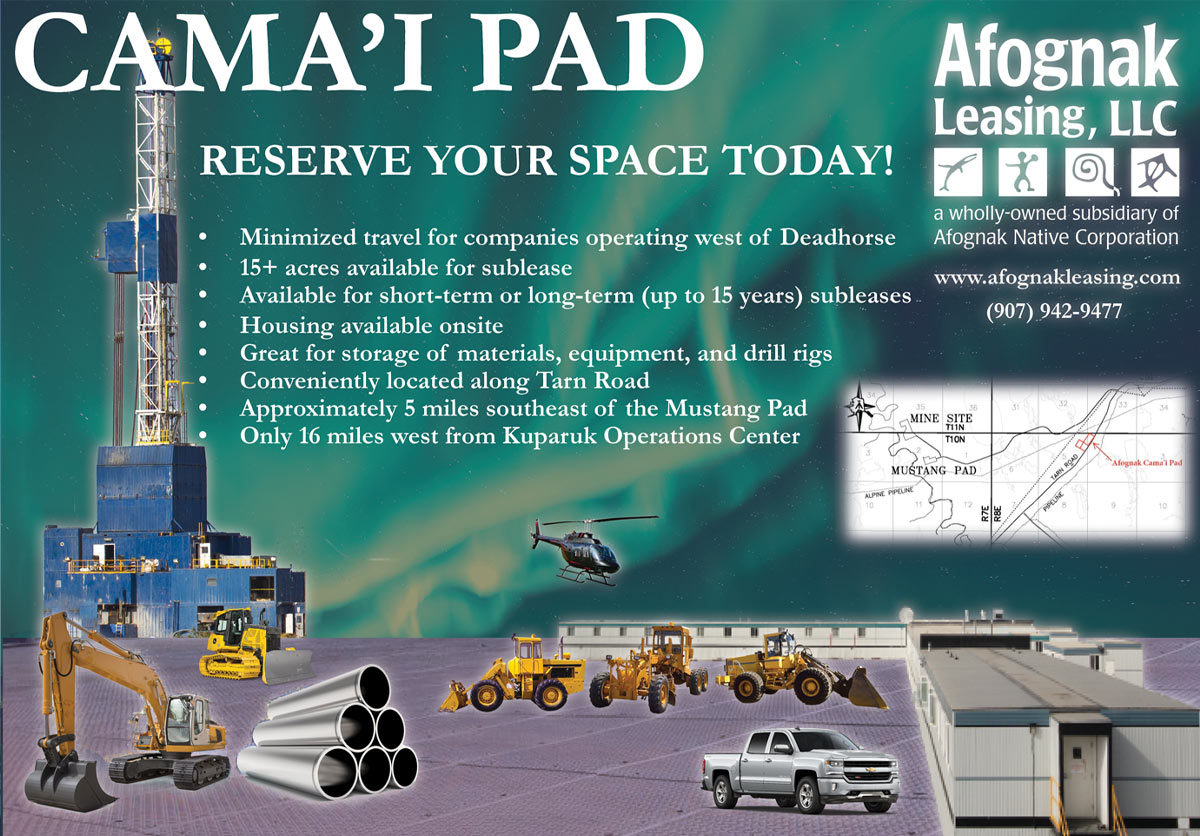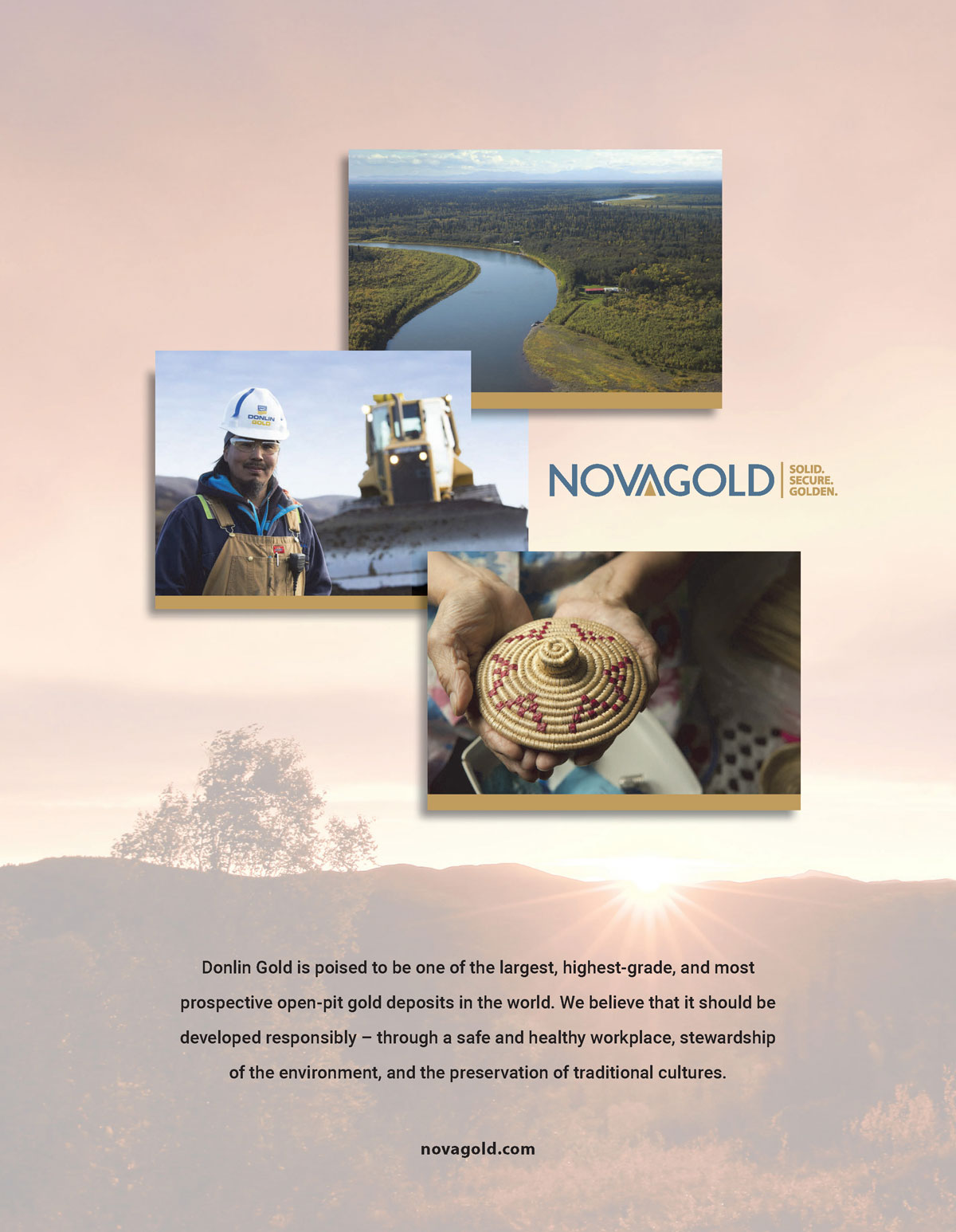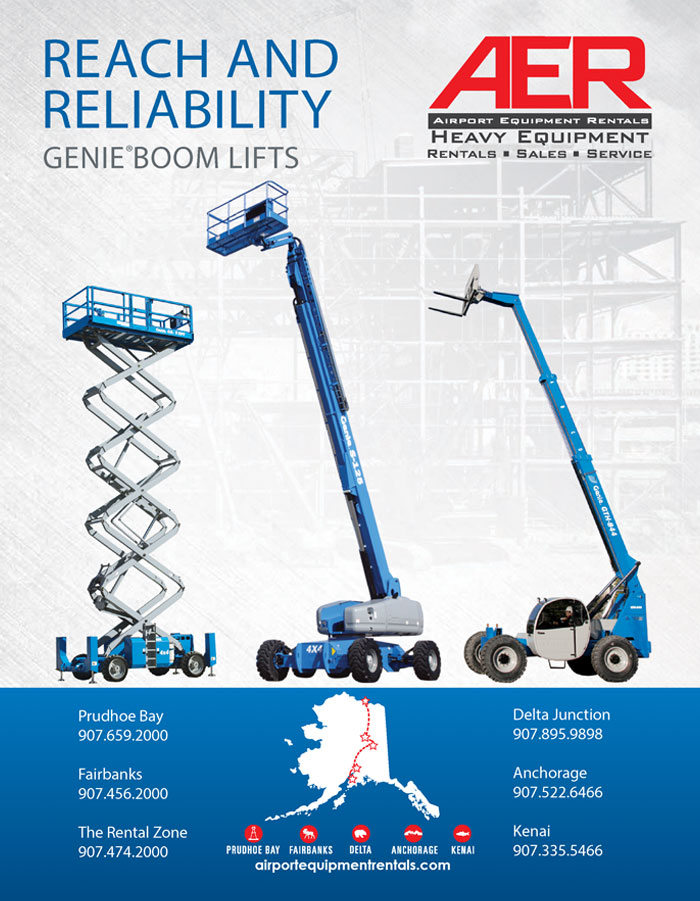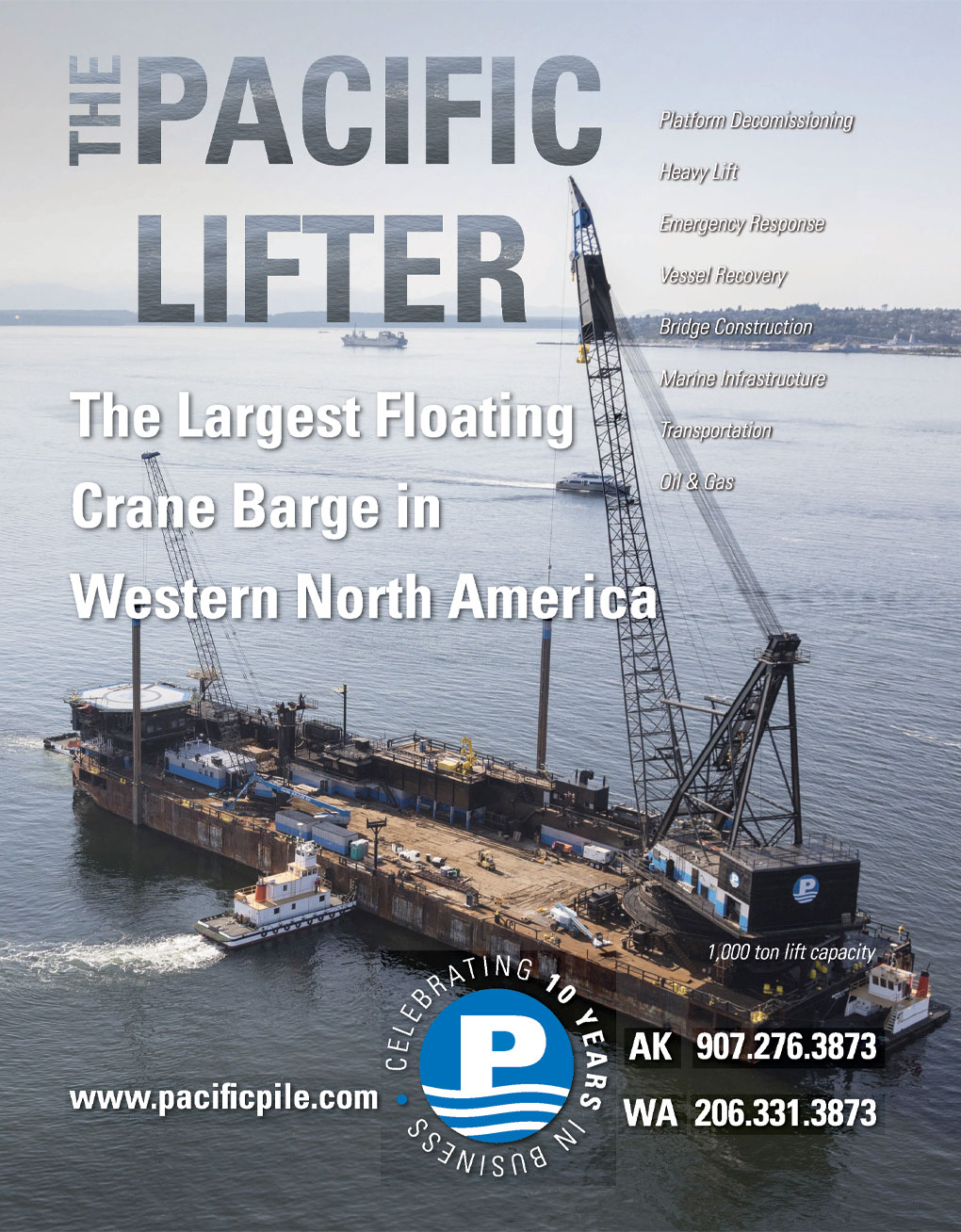Contents
Features
Budding Industry Battles Black Market
By Isaac Stone Simonelli
By Tracy Barbour
By Julie Stricker

By Sam Davenport
By Amy Newman
About The Cover
As the effects of COVID-19 linger long past periods of strict quarantine and hunker down efforts, transportation companies that quickly conformed to CDC recommendations and local mandates continue to adjust every step of the way to ensure Alaskans have what they need when they need it. Carlile President Terry Howard says: “The supply chain is uninterrupted, it’s fully functional, it’s efficient, it’s safe, and it’s working; behind the scenes we’re taking all the necessary precautions to prevent the spread of COVID-19.”
Cover by Monica Sterchi-Lowman • Photography by Kerry Tasker

By Amy Newman
Budding Industry Battles Black Market
By Isaac Stone Simonelli
By Tracy Barbour
By Julie Stricker

By Sam Davenport
About The Cover
As the effects of COVID-19 linger long past periods of strict quarantine and hunker down efforts, transportation companies that quickly conformed to CDC recommendations and local mandates continue to adjust every step of the way to ensure Alaskans have what they need when they need it. Carlile President Terry Howard says: “The supply chain is uninterrupted, it’s fully functional, it’s efficient, it’s safe, and it’s working; behind the scenes we’re taking all the necessary precautions to prevent the spread of COVID-19.”
Cover by Monica Sterchi-Lowman • Photography by Kerry Tasker
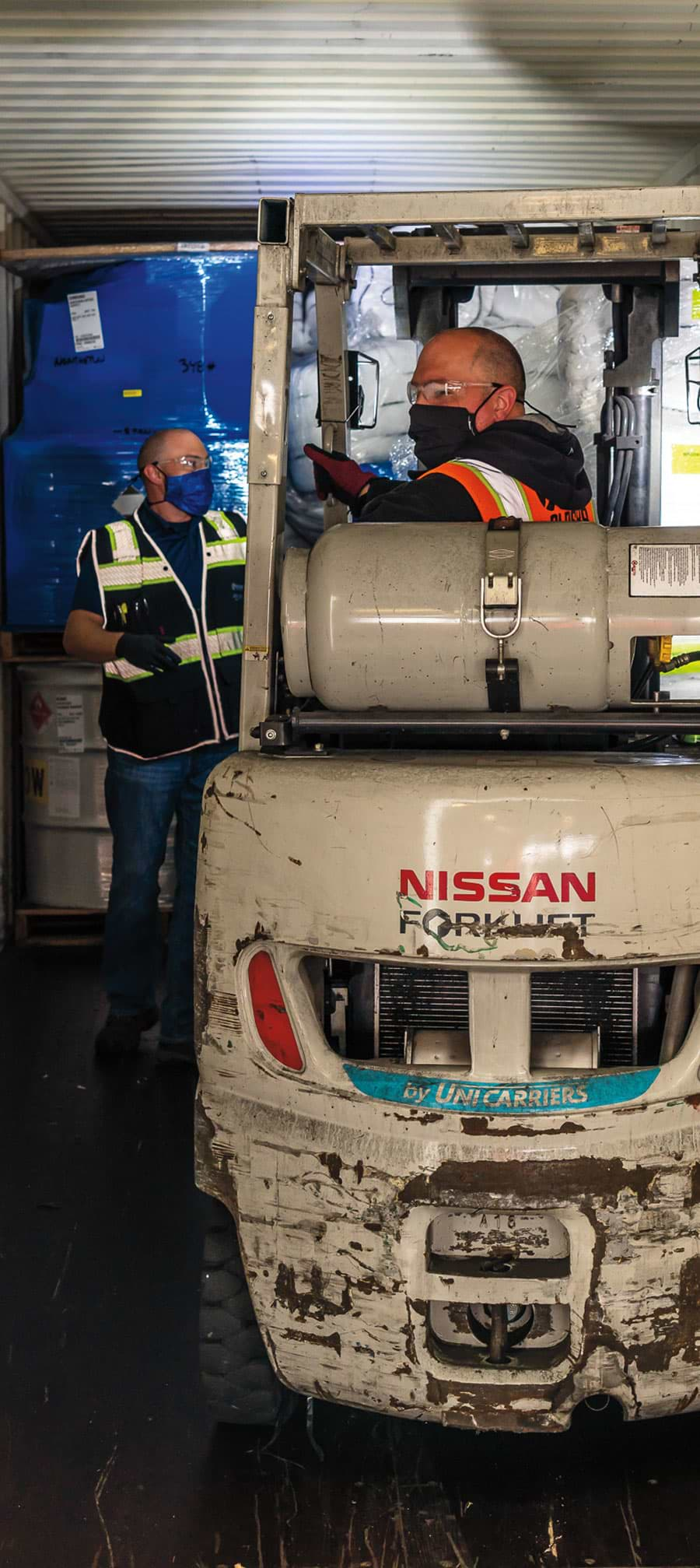
By Tasha Anderson
By Amy Newman
By Vanessa Orr
By Vanessa Orr

By Tasha Anderson
By Amy Newman
By Vanessa Orr
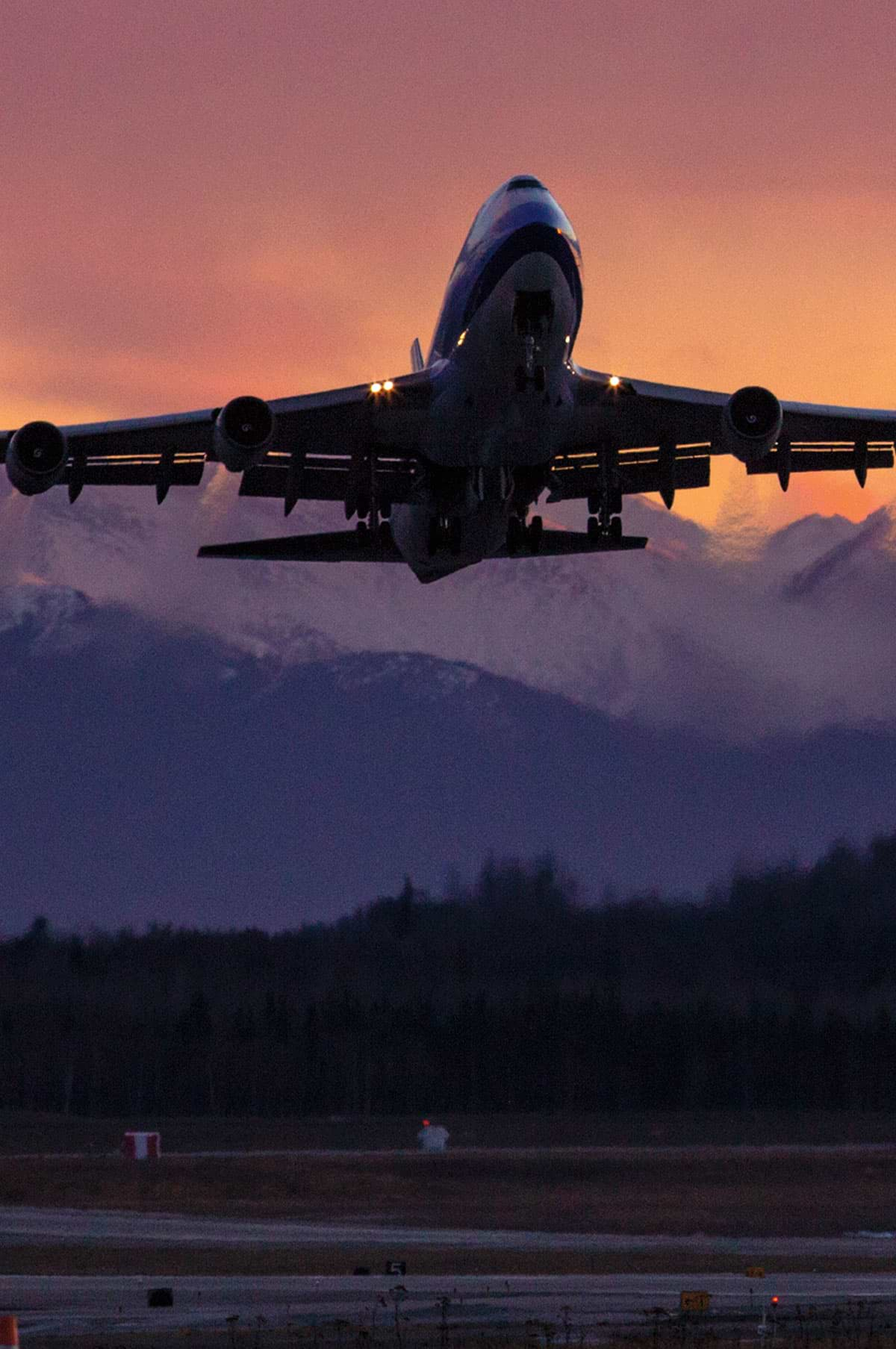
By Vanessa Orr
Quick Reads
*Editor’s Note: Community Events and Business Events will not run this month as most events have been cancelled or postponed due to COVID-19. To see if a specific event has been cancelled, visit our COVID-19 resource page at akbizmag.com/covid-19/covid-19-updates/.

Kerry Tasker
Billie Martin
press@akbizmag.com
Postmaster:
Send address changes to
Alaska Business
501 W. Northern Lights Blvd. #100
Anchorage, AK 99503
From the Editor

hen COVID-19 cases started popping up in Alaska, many residents headed straight to the grocery store to stock up on the basics: rice, beans, flour, anything with bleach or disinfectant, and, of course, toilet paper. And those were just people in the state’s urban areas. Rural residents were left wondering if they’d be able to feed, clothe, and care for their families as the world hunkered down to “flatten the curve.”
The run on stores for supplies is perhaps more understandable in Alaska than other states given that most of what we use and consume must be barged, shipped, driven, or flown here, and in early March not much was clear about the COVID-19 situation, including how the supply chain in Alaska would be affected by a worldwide pandemic. As it turns out, it hasn’t been.

laska banks employ a variety of approaches to build their own investment portfolio and maintain a healthy balance sheet. While their strategies and tactics may differ, their primary objective is the same: to diversify their investments, minimize risk, and generate income.
Historically, financial regulators limited the types of investments that banks can pursue because they are essentially investing depositors’ funds. This helps to reduce risk and minimize the chance that banks are gambling away deposits on hedge funds or other higher-risk investments. Today many banks focus on fixed-income investments like government and corporate bonds, certificates of deposit, and money market funds to earn a steady stream of revenue with less risk than stocks. However, regulatory restrictions have been loosening over the years to allow financial institutions to broaden their investments options.
For financial institutions, the investment portfolio represents an important asset for their operation. At most banks, the investment portfolio serves as a secondary source of both earnings and liquidity. And at some banks, it’s a primary generator of investment earnings.
robust licensing and permitting process offers protection from federal prosecution for the Alaska cannabis industry, but the time and expense of participating in that process has created a market in which licensed businesses are vulnerable to being undercut by black-market prices.
When Alaska legalized cannabis for recreational use in 2015, the industry was able to quickly secure two prominent segments of the market.
“We were able to wrest very many individuals from the black market when the legal industry started. These were people who just wanted the convenience and could afford the higher prices, the people who really didn’t like only being able to go to their guy and just have whatever bags he had that day,” Good Titrations COO Brandon Emmett says. “And then we created a smaller but new consumer group: those individuals who like substances but are also very law abiding.”

robust licensing and permitting process offers protection from federal prosecution for the Alaska cannabis industry, but the time and expense of participating in that process has created a market in which licensed businesses are vulnerable to being undercut by black-market prices.
When Alaska legalized cannabis for recreational use in 2015, the industry was able to quickly secure two prominent segments of the market.
“We were able to wrest very many individuals from the black market when the legal industry started. These were people who just wanted the convenience and could afford the higher prices, the people who really didn’t like only being able to go to their guy and just have whatever bags he had that day,” Good Titrations COO Brandon Emmett says. “And then we created a smaller but new consumer group: those individuals who like substances but are also very law abiding.”
nalytical Consulting Group uses a different approach to consulting with its clients in Alaska and the Lower 48. The Anchorage-based firm, which focuses on outsourced accounting and payroll services, doesn’t just tell companies what to do; it merges consulting with outsourcing services. “When you have someone that is employed in that position, we’re there as their mentor,” says President and CEO Matt Edman. “When they’re not there, we will do that job for them.”
Say, for example, a company’s CFO no longer wants to live in Alaska and unexpectedly resigns. Analytical Consulting Group has the expertise to fill the void. “We’re going to learn everything about your business so that if anybody steps away, we can step in,” Edman says. “For most of our clients, we’re their business continuity plan.”

nalytical Consulting Group uses a different approach to consulting with its clients in Alaska and the Lower 48. The Anchorage-based firm, which focuses on outsourced accounting and payroll services, doesn’t just tell companies what to do; it merges consulting with outsourcing services. “When you have someone that is employed in that position, we’re there as their mentor,” says President and CEO Matt Edman. “When they’re not there, we will do that job for them.”
Say, for example, a company’s CFO no longer wants to live in Alaska and unexpectedly resigns. Analytical Consulting Group has the expertise to fill the void. “We’re going to learn everything about your business so that if anybody steps away, we can step in,” Edman says. “For most of our clients, we’re their business continuity plan.”
laskans have some experience both with isolation and sudden emergencies. Earthquakes, volcanic eruptions, seasonal flooding, and wildfires seldom schedule their arrival. And while emerging technology and developing infrastructure have allowed Alaska to become more connected, as Alaskans we know we’re still at the end of the road—even more so for those living beyond the road in Alaska’s remote communities.
So while the sudden appearance of COVID-19 in our lives, quickly followed by orders to stop leaving our homes or socializing with anyone, was definitely not normal, at its root it wasn’t completely unfamiliar, and across the state Alaskans demonstrated once again their willingness to do what needs to be done to take care of each other.
he importance of the aviation industry to Alaska can’t be understated; not only does it provide a huge number of jobs in the state—almost 8 percent of all employment—but it is also responsible for transporting much of the food, products, and other necessities that residents need in their daily lives.
The industry also transports tourists, who bring money into the state, as well as much of the equipment needed to keep Alaska’s manufacturing and natural resource industries running. And with more than 82 percent of Alaska’s communities not connected to the road system, it is at times a literal lifeline for those living outside the handful of urban areas.
eality television has painted a somewhat distorted picture of life in Bush Alaska. Shows like Alaskan Bush People and Alaska: The Last Frontier depict families living life off-the-grid, chopping wood to build their cabins, and hunting and gathering to put food on the table.
But even the hardiest of those living in the Alaska Bush head to the store at least occasionally to stock their pantry and purchase clothes, furniture, and other personal items.
It just takes a bit more effort—and an airplane—to do what is an easy afternoon errand for the rest of Alaska.
“We’re a service provider,” says Clinton White, owner and operator of Anchorage-based Greatland Grocery & Supply, an online store that serves all of Alaska. “We market ourselves as a grocery store, but really we’re a supplier of goods that Bush communities need.”
Even for businesses that predominantly serve more traditional customers, Bush orders still comprise a significant portion of their sales.
“It’s amazing how much stuff goes out in the Bush,” says Ron Bailey, president of Bailey’s Furniture, which has showrooms in Anchorage, Fairbanks, Wasilla, and Soldotna. “I’d estimate that 10 to 15 percent of our sales are Bush orders.”

eality television has painted a somewhat distorted picture of life in Bush Alaska. Shows like Alaskan Bush People and Alaska: The Last Frontier depict families living life off-the-grid, chopping wood to build their cabins, and hunting and gathering to put food on the table.
But even the hardiest of those living in the Alaska Bush head to the store at least occasionally to stock their pantry and purchase clothes, furniture, and other personal items.
It just takes a bit more effort—and an airplane—to do what is an easy afternoon errand for the rest of Alaska.
“We’re a service provider,” says Clinton White, owner and operator of Anchorage-based Greatland Grocery & Supply, an online store that serves all of Alaska. “We market ourselves as a grocery store, but really we’re a supplier of goods that Bush communities need.”
Even for businesses that predominantly serve more traditional customers, Bush orders still comprise a significant portion of their sales.
“It’s amazing how much stuff goes out in the Bush,” says Ron Bailey, president of Bailey’s Furniture, which has showrooms in Anchorage, Fairbanks, Wasilla, and Soldotna. “I’d estimate that 10 to 15 percent of our sales are Bush orders.”
Plans Change.
Deadlines Don’t.
Download at www.lynden.com/mobile
ummertime is construction season in Alaska, and while no one can yet predict what the tourist season holds, Alaska’s highways are already heavily used, even before the influx of independent travelers.
There are some places where substantial traffic—and sometimes road conditions—make it more hazardous for drivers to traverse. As a result, Alaska’s Department of Transportation and Public Facilities (DOT&PF) has established Safety Corridors in areas with a higher than average incidence of fatal and serious injury crashes. DOT&PF is also responsible for overseeing the federal Highway Safety Improvement Program (HSIP), which identifies and funds a wide variety of highway safety projects with the goal of saving lives and reducing injuries.
1959/1959 |10/10
5901 Lockheed Ave.
Anchorage, AK 99502
907-334-5100
1988/ 1988 | 150/150
1994/1994 | 12/12
4700 Old International Airport Rd.
Anchorage, AK 99502
alaskacargo.com
cargo@alaskaair.com
800-225-2752
1932/1932 | 24,000/3,000
4000 W. 50th Ave., Ste. 6
Anchorage, AK 99502
aln@alaskaaircargo.com
907-248-4697
1969/1969 | 40/5
2301 Merrill Field Dr.
Anchorage, AK 99501
FlyAAT.com
Charters@FlyAAT.com
907-276-5422
1984/1984 | 23/23
eologists knew more than a century ago there was oil on Alaska’s North Slope. A 1921 report to the US Geological Survey that discussed Alaska petroleum noted areas of the state had oil seeps that looked commercially promising, including “some indications of oil in the extreme northern part of Alaska, a region at present almost inaccessible.”
At that time, geologists relied on obvious signs of oil, such as seeps, to find potential oil fields. In the ‘20s, a method of using sound waves to define underground rock layers was developed. Called 2D seismic surveys, they allowed geologists to see thin slices of the layers of rock underground. In the ‘80s, 3D surveys widened and sharpened that view. Today, 4D surveys are common. Each advance resulted in more data points for a more accurate look at what was happening underground.

Senior Account Manager
t’s important to take a stand in life, to be steadfast in who you are. The same can be said for your business—and how you position it in the marketplace. In a marketing sense, positioning is how your business, products, and services are perceived to be different from those of your competitors.
Here are three steps that will allow you to establish a strong marketing position:
1. Develop a Positioning Strategy—
Analyze the characteristics of your business and those of your competitors. Be honest about your strengths and weaknesses as you determine how your business stacks up. Research your competitors to determine what they’re doing and identify how you do it better. What does your business offer that’s unique? How do you excel and what expertise do you have over your competition? How do you want your clients to think about and view your business? Formalize this strategy in writing and discuss it with your staff to make sure everyone is on the same page.
MINING
Economie$
Economie$
Economie$

he mining industry plays an important role in the economy of more than seventy communities throughout the state. Whether the mines produce zinc, lead, coal, gravel, silver, or gold, the direct and indirect financial impacts on the surrounding area are significant, according to a McDowell Group report commissioned by the Alaska Mining Association.
“The most important impacts are related first to the jobs and the wages that a mine creates,” McDowell Group Senior Vice President Jim Calvin says.
“Mines are fairly labor intensive; they will typically employ several hundred workers. And mines are also often among the largest employers in terms of headcount and total payroll over the course of a year.”

Above
Below
and
maintaining utility lines
he decision to bury a utility line depends on many factors, such as climate and population density. Alaska’s utilities decide how to provide services to a community based on its needs and characteristics.
Alaska Village Electric Cooperative (AVEC) has more power plants than all of Alaska’s other electric cooperatives combined. The nonprofit serves residents in fifty-eight locations across Alaska, from Kodiak Island to Yakutat and Minto, which is the only community in the cooperative’s network accessible by road. AVEC runs more than 150 diesel generators for more than 400,000 hours a year to provide services to its customers.


obody anticipates summer quite like Alaskans. Months of darkness, mountains of snow, and freezing temperatures yield, seemingly overnight, to long, sunlit days and, with the kids out of school, time to travel to the Lower 48 and beyond for vacation.
Summer 2020, however, is shaping up to be more than just a little bit different.
As this article is being written, Alaskans are hunkered down at home. Every resident or visitor who enters the state—whether by land, sea, or air—is subject to a mandatory 14-day home quarantine, causing many to cancel travel plans. The cruise ship industry, which brings more than 1 million visitors to the state each summer, has canceled excursions through at least June 30; airlines have reduced flights in and out of the state; and all but the most essential services are closed.
alaskamaterials.com
Following the US Bureau of Land Management releasing the EIS, the final step in the permitting process for the project is the issuance of the Record of Decision by the BLM and the issuance of the Clean Water Act Section 404 permit from the US Army Corp of Engineers. Trilogy Metals expects these two items to be issued concurrently within the next couple of months.
trilogymetals.com
 446,368 barrels
446,368 barrels -13% change from previous month
-13% change from previous monthSource: Alaska Department of Natural Resources
 $13.03 per barrel
$13.03 per barrel 40% change from previous month
40% change from previous monthSource: Alaska Department of Natural Resources
 345,010 Labor Force
345,010 Labor Force 5.6% Unemployment
5.6% UnemploymentSource: Alaska Department of Labor and Workforce Development
 Bob Warthen has been selected to fill the position of Vice President, Commercial Services Administration, Business and Commercial Services. Warthen is a skilled leader with more than twenty-five years of industry experience. He has been employed with Alaska USA since 2005, most recently as credit administration manager.
Bob Warthen has been selected to fill the position of Vice President, Commercial Services Administration, Business and Commercial Services. Warthen is a skilled leader with more than twenty-five years of industry experience. He has been employed with Alaska USA since 2005, most recently as credit administration manager.
 Alaska Pacific University (APU) selected Valerie Nurr’araaluk Davidson as its next President. Davidson served as commissioner of the Alaska Department of Health & Social Services and then the lieutenant governor under then-Governor Bill Walker. Prior to that, she worked for more than fifteen years as a national policymaker, focusing on matters affecting Indigenous health.
Alaska Pacific University (APU) selected Valerie Nurr’araaluk Davidson as its next President. Davidson served as commissioner of the Alaska Department of Health & Social Services and then the lieutenant governor under then-Governor Bill Walker. Prior to that, she worked for more than fifteen years as a national policymaker, focusing on matters affecting Indigenous health.
Davidson earned a juris doctorate with a certificate in Indian law from the University of New Mexico School of Law and a bachelor’s degree in education with a minor in bilingual education from the University of Alaska Southeast.


Regulations are changing constantly. For the most up-to-date information visit www.nac.aero.

Regulations are changing constantly. For the most up-to-date information visit www.nac.aero.

Alaska Trends
his year, celebrating the transportation industry in June seems particularly well-timed; despite a global pandemic, our transportation professionals have kept shelves stocked and people moving (whenever moving people couldn’t be avoided) while adhering to strict cleanliness and safety protocols. Through it all, Alaskans have been able to rely on an industry that takes its responsibilities to the communities it serves seriously.
It requires infrastructure, equipment, and expertise to “Keep Alaska Moving,” so for our June Alaska Trends we’re presenting a little more information about transportation in the Last Frontier. The facts presented here are sourced from Department Fast Facts: Prepared for Legislative Session 2020 by the Alaska Department of Transportation & Public Facilities.



